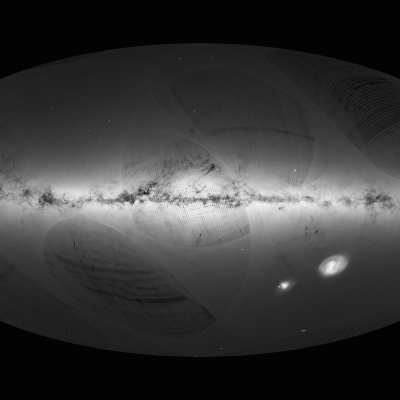The European Space Agency (ESA) today released the largest dataset yet from the Gaia satellite, an orbiting observatory mapping the Milky Way.
Launched in 2013, Gaia is mapping our Galaxy in unprecedented detail. The latest release includes high accuracy positions for almost 1.7 billion stars, 600 times the number in the satellite’s first dataset, and far in excess of anything achieved before.
Professor John Zarnecki, the President of the Royal Astronomical Society, said:
‘Gaia is the culmination of efforts to map the Galaxy since the dawn of telescopic astronomy. In 1609 Galileo observed that the Milky Way, which appears as a band of light in the night sky, was composed of a vast number of individual stars. Astronomers later realised this is the view of the galaxy we live in from our home here on Earth.’
‘Our founding president, Sir William Herschel, also attempted to map the Galaxy more than two centuries ago, and would have been delighted by today’s results.’
‘It gives me enormous pleasure to congratulate the scientists and engineers who work on Gaia, based in many different European countries including the UK, for their continuing achievement. This mission is measuring the Universe in a way we could not have imagined even a few decades ago.’
The data release was announced at a briefing at the Royal Astronomical Society this morning. By the end of its life in 2024, Gaia is expected to have surveyed up to a tenth of all the stars in our Galaxy, and the data from this release will provide astronomers around the world with a rich source of material for many years to come.
Media contacts
Dr Robert Massey
Royal Astronomical Society
Tel: +44 (0)20 7292 3979
Mob: +44 (0)7802 877 699
press@ras.ac.uk
Dr Morgan Hollis
Royal Astronomical Society
Tel: +44 (0)20 7292 3977
Mob: +44 (0)7802 877 700
press@ras.ac.uk
Dr Helen Klus
Royal Astronomical Society
Tel: +44 (0)20 7292 3976
press@ras.ac.uk
Images and captions

Gaia’s all-sky view of our Milky Way Galaxy and neighbouring galaxies, based on measurements of nearly 1.7 billion stars. The map shows the total brightness and colour of stars observed by the ESA satellite in each portion of the sky between July 2014 and May 2016.
Credit: ESA / Gaia / DPAC

An all-sky view of stars in our Galaxy and neighbouring galaxies, based on the first year of observations from ESA’s Gaia satellite, from July 2014 to September 2015.
Credit: ESA / Gaia/ DPAC
Licence: CC BY-SA 3.0 IGO
Notes for editors
The Royal Astronomical Society (RAS), founded in 1820, encourages and promotes the study of astronomy, solar-system science, geophysics and closely related branches of science. The RAS organizes scientific meetings, publishes international research and review journals, recognizes outstanding achievements by the award of medals and prizes, maintains an extensive library, supports education through grants and outreach activities and represents UK astronomy nationally and internationally. Its more than 4,000 members (Fellows), a third based overseas, include scientific researchers in universities, observatories and laboratories as well as historians of astronomy and others.
The RAS accepts papers for its journals based on the principle of peer review, in which fellow experts on the editorial boards accept the paper as worth considering. The Society issues press releases based on a similar principle, but the organisations and scientists concerned have overall responsibility for their content.
Follow the RAS on Twitter, Facebook and Instagram

